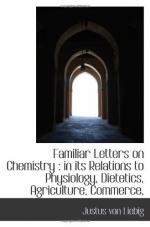Out of those substances which are adapted to the formation of blood, are formed all the organised tissues. The other class of substances, in the normal state of health, serve to support the process of respiration. The former may be called the plastic elements of nutrition; the latter, elements of respiration.
Among the former we reckon—
Vegetable fibrine.
Vegetable albumen.
Vegetable caseine.
Animal flesh.
Animal blood.
Among the elements of respiration in our food, are—
Fat. Pectine.
Starch. Bassorine.
Gum. Wine.
Cane sugar. Beer.
Grape sugar. Spirits.
Sugar of milk.
The most recent and exact researches have established as a universal fact, to which nothing yet known is opposed, that the nitrogenised constituents of vegetable food have a composition identical with that of the constituents of the blood.
No nitrogenised compound, the composition of which differs from that of fibrine, albumen, and caseine, is capable of supporting the vital process in animals.
The animal organism unquestionably possesses the power of forming, from the constituents of its blood, the substance of its membranes and cellular tissue, of the nerves and brain, and of the organic part of cartilages and bones. But the blood must be supplied to it perfect in everything but its form—that is, in its chemical composition. If this be not done, a period is rapidly put to the formation of blood, and consequently to life.
This consideration enables us easily to explain how it happens that the tissues yielding gelatine or chondrine, as, for example, the gelatine of skin or of bones, are not adapted for the support of the vital process; for their composition is different from that of fibrine or albumen. It is obvious that this means nothing more than that those parts of the animal organism which form the blood do not possess the power of effecting a transformation in the arrangement of the elements of gelatine, or of those tissues which contain it. The gelatinous tissues, the gelatine of the bones, the membranes, the cells and the skin suffer, in the animal body, under the influence of oxygen and moisture, a progressive alteration; a part of these tissues is separated, and must be restored from the blood; but this alteration and restoration are obviously confined within very narrow limits.
While, in the body of a starving or sick individual, the fat disappears and the muscular tissue takes once more the form of blood, we find that the tendons and membranes retain their natural condition, and the limbs of the dead body their connections, which depend on the gelatinous tissues.
On the other hand, we see that the gelatine of bones devoured by a dog entirely disappears, while only the bone earth is found in his excrements. The same is true of man, when fed on food rich in gelatine, as, for example, strong soup. The gelatine is not to be found either in the urine or in the faeces, and consequently must have undergone a change, and must have served some purpose in the animal economy. It is clear that the gelatine must be expelled from the body in a form different from that in which it was introduced as food.




